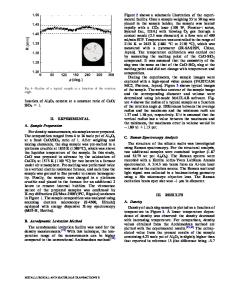Viscosity Measurement and Structure Analysis of Cr 2 O 3 -Bearing CaO-SiO 2 -MgO-Al 2 O 3 Slags
- PDF / 2,830,676 Bytes
- 11 Pages / 593.972 x 792 pts Page_size
- 10 Downloads / 388 Views
ODUCTION
THE viscosity of a molten slag is a critical property because it greatly affects the mass transfer of elements within the slag, and the yield and cleanness of the metal melt obtained via pyrometallurgical processes.[1] Recently, a consensus has been reached that the macroscopic physical properties of a slag, such as viscous flow behavior, are determined by its structure.[2–4] Hence, much research has focused on understanding the structure of molten slag.[5–11] Generally, the number of non-bridging oxygen (NBO) atoms per tetrahedrally coordinated atom (hereinafter denoted by NBO/T) and the optical basicity after charge balancing, Kcorr, are used to characterize the structure and degree of polymerization (DOP) of molten slags.[12] Both parameters have a similar effect on the DOP of a molten slag, with an increase in NBO/T or Kcorr leading to a decrease in the DOP. Behera et al.[13] reported that the viscosity of molten Al2O3-Cr2O3-CaO-CaF2 slags decreases as NBO/T and Kcorr increase, and thus the viscosity decreases as the DOP decreases. With the introduction of advanced investigative techniques, such as Raman spectroscopy, detailed structural information, which can be obtained via the deconvolution of Raman spectra, can elucidate the parameters that alter the viscosity of molten slags. Kim et al.[14] reported that the viscosity of calcium aluminosilicate melts with low silica QIUHAN LI, JINTAO GAO, YANLING ZHANG, ZHUOQING AN, and ZHANCHENG GUO are with the State Key Laboratory of Advanced Metallurgy, University of Science & Technology Beijing, 100083 Beijing, China. Contact e-mail: [email protected] Manuscript submitted July 18, 2016. Article published online November 30, 2016. 346—VOLUME 48B, FEBRUARY 2017
contents decreases as the number of bridging oxygen atoms (hereinafter denoted by BO) in the [AlO4] tetrahedral units (QnAl , where n is the number of BO for the given unit) decreased. For example, the viscosity decreased when fully polymerized Q4Al units were converted into simpler Q3Al and Q2Al units by increasing the CaO/Al2O3 ratio. The average number of BO of each sample, which represents the contribution of each unit to the DOP, is widely employed by many researchers in combination with Raman spectroscopy. In general, a higher BO value will increase the DOP. Wang et al.[15] reported that the sulfide capacity of a CaO-MgOAl2O3-SiO2-CrOx slag decreases as BO increases, which indicates that a high DOP is not beneficial for desulfurization processes. Li et al.[16] observed that both BO and the DOP increase as the TiO2 content of a CaO-SiO2-CaF2-TiO2 slag increases. However, despite the increase in the DOP, the viscosity of the slag decreased, which was attributed to the low strength of Ti-O bonds. In most cases, the structure–viscosity relationship of a melt can usually be expressed as the change in viscosity as the DOP increases or decreases. Cr is an important alloying element for many different metallic materials. Regarding the smelting and refining of Cr-bearing metallic materials, Cr2O3-bea
Data Loading...











